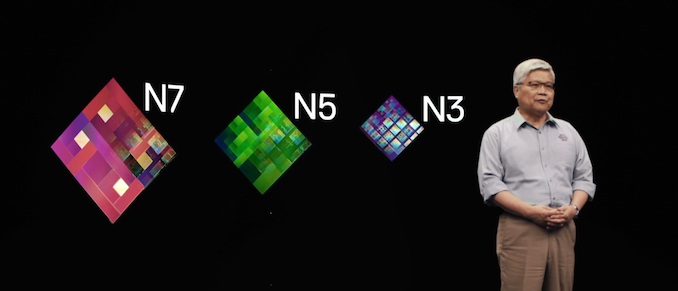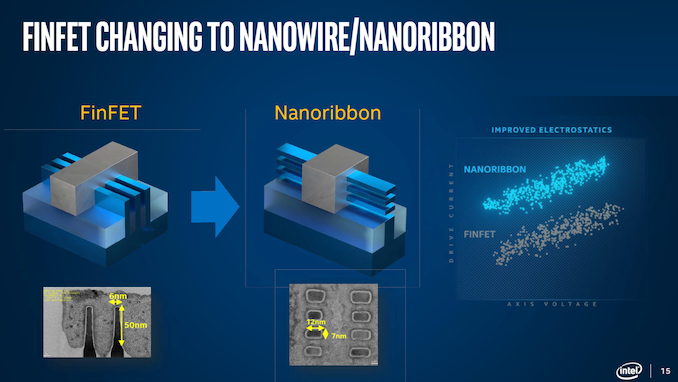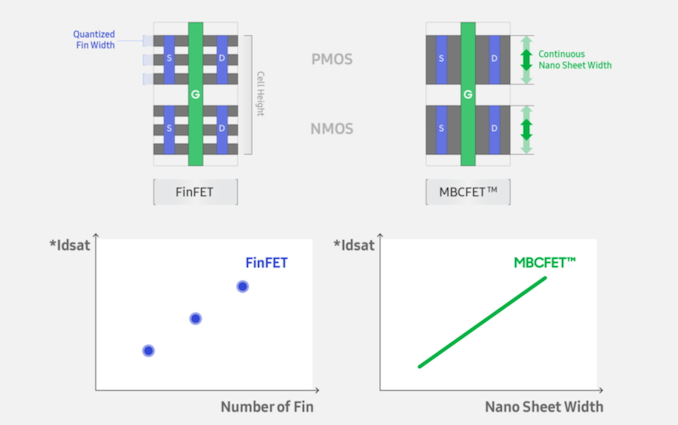Where are my GAA-FETs? TSMC to Stay with FinFET for 3nm
by Dr. Ian Cutress on August 26, 2020 12:00 PM EST
As we passed that 22nm to 16nm barrier, almost all the major semiconductor fabrication companies on the leading edge transitioned from planar transistors to FinFET transistors. The benefits of FinFET were numerous, including better drive currents and lower leakage, better scalability, faster switching times, and an overall better transistor of choice for semiconductor logic. With FinFETs, and multiple rounds of improvements, the technology has scaled from Intel’s first 22nm products down to the 5nm products we will see from TSMC’s partners this year.
As expected, at some point the ability to scale a FinFET will become prohibitive, and new technologies will be needed to help continue the scaling. Research on post-FinFET transistor technology has been progressing at a break-neck pace, and most attention has been moved into ‘Gate-All-Around’ technology, which lifts the channel and allows the channel width to scale as needed for the type of transistor in use. GAA-FETs offer significant advantages when it comes to transistor performance control – for most FinFET processes, foundries can offer several designs based on voltage and performance, but GAA-FET designs turn those discrete options into something more continuous. You might see these referred to as nanosheets, or nanowires.
As is perhaps to be expected, GAA-FET designs (and layered GAA-FETs) are more complex to build than FinFETs or planar transistors. The first GAA-FET demonstration was in 1986, and in 2006 a 3nm implementation was demonstrated. However, building it in a lab compared to building it at scale as part of a foundry process available to customers is a different scale of complexity. At a number of technical semiconductor conferences through 2018 and 2019, a number of design companies and foundry offerings have discussed GAA-FET or similar designs as part of their upcoming portfolio.
Most notably, Intel has mentioned that they will start using it within the next 5 years, which would put it around its 5nm-3nm node technologies.
Samsung has announced its intention to deliver its version, known as MBC-FETs, as part of its 3nm process node, expected to be in volume manufacturing by late 2021. In May 2019, the company released a statement that the first v0.1 version of its 3GAE PDK was ready for customers. Over a year later, we would expect this to be on track – the 2020 version of Samsung’s Foundry Forum, which was delayed due to COVID, should be happening later this year.
As these sorts of transistors grow in use, we expect the range of sheet widths available to increase, as well as the number of stacked layers in a GAA design. CEA-Leti this year, at the 2020 Symposia on VLSI Technology and Circuits, demonstrated a 7-layer GAA-FET using nanosheets specifically for high-performance computing.
So what has happened with TSMC? As part of the Technology Symposium, it has stated that for its 3nm process technology it will remain with FinFETs. The company states that it has enabled a significant update to its FinFET technology to allow performance and leakage scaling through another iteration of its process node technology. TSMC’s N3 will use an extended and improved version on FinFET in order to extract additional PPA - up to 50% performance gain, up to 30% power reduction, and 1.7x density gain over N5. TSMC stated the predictability of FinFETs will help enable the company deliver the technology on an approved timescale.
This last statement is more than telling – if the development of FinFETs, now on its 3rd/4th/5th generation (depending on the foundry), has enabled a level of comfort and predictability that a first generation of GAA-FET cannot provide, then in order to satisfy its big customers (almost all leading-edge logic silicon), it has to keep to its cadence. That being said, there could be a chance for TSMC to offer GAA-FETs on different versions of its 3nm nodes in the future if it wishes, however the company has not made any public statements at this time to this effect, compared to Intel and Samsung.
As always with these technologies, the goal is to scale and bring some reality to wherever Moore’s Law is going. TSMC’s customers will have to wait until later to see if GAA-FETs can bring a more optimized flavor of performance to the table.
Related Reading
- TSMC Details 3nm Process Technology: Full Node Scaling for 2H22 Volume Production
- TSMC To Build 5nm Fab In Arizona, Set To Come Online In 2024
- TSMC & Broadcom Develop 1,700 mm2 CoWoS Interposer: 2X Larger Than Reticles
- TSMC Boosts CapEx by $1 Billion, Expects N5 Node to Be Major Success
- Early TSMC 5nm Test Chip Yields 80%, HVM Coming in H1 2020
- TSMC: 5nm on Track for Q2 2020 HVM, Will Ramp Faster Than 7nm
- TSMC: N7+ EUV Process Technology in High Volume, 6nm (N6) Coming Soon















37 Comments
View All Comments
FreckledTrout - Wednesday, August 26, 2020 - link
So will Intel's SuperFin(lord I hate that name) and TSMC's approaches be similar?" 50% performance gain, up to 30% power reduction, and 1.7x density gain over N5" If that's the case then I can see why they are not moving to GAA-FET.
Arsenica - Wednesday, August 26, 2020 - link
TSMC is targeting GAA for their 2 "nm" node.SuperFin is an awful name. They should have followed other foundries in re-naming their derivative nodes as if they were a different node (as GloFo's 14nm->12nm or TSMC's 10nm->7nm).
Node "names" have for long lost any relation with the actual size of the transistors, so for marketing purposes it would have been more effective if Intel had re-named 10++ into 9nm or 8nm instead of SuperFin.
At this rate Intel will be hyping their MegaRibbon 5nm while TSMC is talking marketing "picometers".
name99 - Wednesday, August 26, 2020 - link
'TSMC is targeting GAA for their 2 "nm" node.'That's a strong statement. TSMC is happy to mix and match stable, tested technology with ONE new test item. (Think, eg, N7+ as a trial of EUV)
I could imagine that if their current experimentation around GAA goes well, they might introduce an N3+ a year after N3 that is basically everything the same as N3 except using GAA (and presumably with GAA benefits, so some combination of lower power, slightly higher frequency or [of particular interest to AMD] the same high frequency as N3 but in rather smaller cells).
III-V - Wednesday, August 26, 2020 - link
"That's a strong statement."I mean, that's not the first time it's been said either.
saratoga4 - Wednesday, August 26, 2020 - link
I won't be at all surprised if they offer the 3nm BEOL with GAA and then call it "2nm", similar to how they did with 20nm and finfets.astroboy888 - Thursday, August 27, 2020 - link
TSMC 2nm will be a full node. Not an iteration of previous process. Brand new fabs are being built specifically for it.hecksagon - Wednesday, August 26, 2020 - link
"Most notably, Intel has mentioned that they will start using it within the next 5 years..."*Holds Breath*
Kamen Rider Blade - Wednesday, August 26, 2020 - link
If they're going to come up with dumb names like "SuperFin" or "MegaRibbon".They should stick with 10nm+², or 10nm+³
name99 - Wednesday, August 26, 2020 - link
Don't worry! Here's how this will play out.2022: Intel will announce how their 5nm UltraSheets are the best transistors ever! And they'll ship just as soon as those last pesky problems with 7nm are sorted out.
2022: TSMC keeps their mouths shut as usual.
2023: TSMC announces GAA sheets (just sheets, no branding nonsense) for 2nm
2024: TSMC actually SHIPS 2nm GAA
2026: Intel tells us that UltraSheets will ship any day now, just you wait, and they will be awesome, I tell you, even better than what we promised in 2022!!!
fallaha56 - Wednesday, August 26, 2020 - link
ha yes, this forum really needs a like button lol